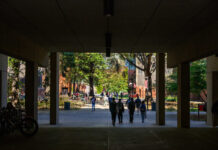It’s been a long and winding road for the Louisville, Ky., school once dubbed “the Harvard of black Kentucky.” The story is one of struggle, persistence and, ultimately, redemption.
In February, the school, founded in 1879 by 12 former African American slaves, expects to become one of a very few African American colleges to receive accreditation from the nationally-recognized Association for Biblical Higher Education.
Those who know the history of the school at Seventh and Kentucky streets in one of the city’s poorest neighborhoods say that’s no small triumph. And in the end, the same predominantly white university that some believe abandoned the college in its prime has helped it rise from the ashes decades later.
When Lexington, Ky., pastor William Simmons began leading the school—first known as Kentucky Normal Theological Institute –it had only two teachers, 13 students and no operating capital. By 1884, its enrollment had grown to 205 students and it was renamed State University.
In 1918, former slave and State University graduate Charles Parrish took over as president, renaming the school Simmons University and establishing a small endowment. By 1922, Simmons enrolled more than 500 students and had become the college of choice for Kentucky’s black middle class.
The school flourished over the next several years, producing notables such as Robert Todd Duncan, who inspired the character Porgy in George Gershwin’s 1935 opera “Porgy and Bess,” and sociologist Charles Parrish Jr., the first black professor to teach at the University of Louisville and a white public university in the South.
Its teachers included Jane Alice Browne Bond, grandmother of NAACP board chairman Julian Bond, and Mary Virginia Cook Parrish, who helped found the nation’s first black YWCA.
Then came the Great Depression, an event that shook the school to its core.
In 1930, despite school leaders’ best efforts, the building at Seventh and Kentucky could not be saved from foreclosure. Simmons’ campus was sold to the University of Louisville and became home to the newly established Louisville Municipal College for the Colored.
Simmons’ students and teachers, not to be deterred, moved several blocks away to new quarters at 18th and Dumesnil streets, where the school continued educating black clergy from around Kentucky.
In 1951, UofL integrated, closed Louisville Municipal College and sold the building at Seventh and Kentucky to the local public K-12 school system for use as an elementary school.
Fast forward to 2005, when Kevin Cosby, pastor of Louisville’s St. Stephens Baptist Church, bought the structure to house the church’s youth ministry and community outreach programs. Cosby, whose grandfather had attended Simmons, knew the institution’s history and realized that its past told a remarkable story of African American educational achievement.
Before long, Cosby had launched an all-out campaign to restore Simmons College to a full-fledged place of higher learning.
“The key to moving toward an unlimited future lies in knowing the strength of one’s past,” Cosby said. “We haven’t known our history. We’ve not been in touch with the greatness of our past.”
In 2006, UofL President James Ramsey learned of the fractured history between the two schools when visiting Simmons at Cosby’s invitation. The two presidents became friends and Cosby, who later became a member of UofL’s Board of Trustees, approached Ramsey with a proposal. He asked if UofL would partner with Simmons to boost higher learning opportunities for African American students, particularly those from the city’s economically disadvantaged West End.
Ramsey agreed, and in 2010 UofL signed an agreement with Simmons to align Simmons’ general education requirements so that students could more easily transfer academic credits between the two schools.
“This historic agreement is proof of our joint commitment to providing an affordable education to all who seek to better their lives,” Ramsey said. “It’s also a testament to Rev. Cosby’s persistence in seeking partnerships and opportunities for the less fortunate.”
Now, with accreditation just around the corner, Cosby—who is president of the school but who has never accepted any compensation for the job—is starting to realize his dream of restoring the 134-year-old college.
“Simmons’ history must be kept alive, because if black people fresh out of slavery could establish a university with a 5 percent literacy rate, then we are without excuse today,” he said.

























